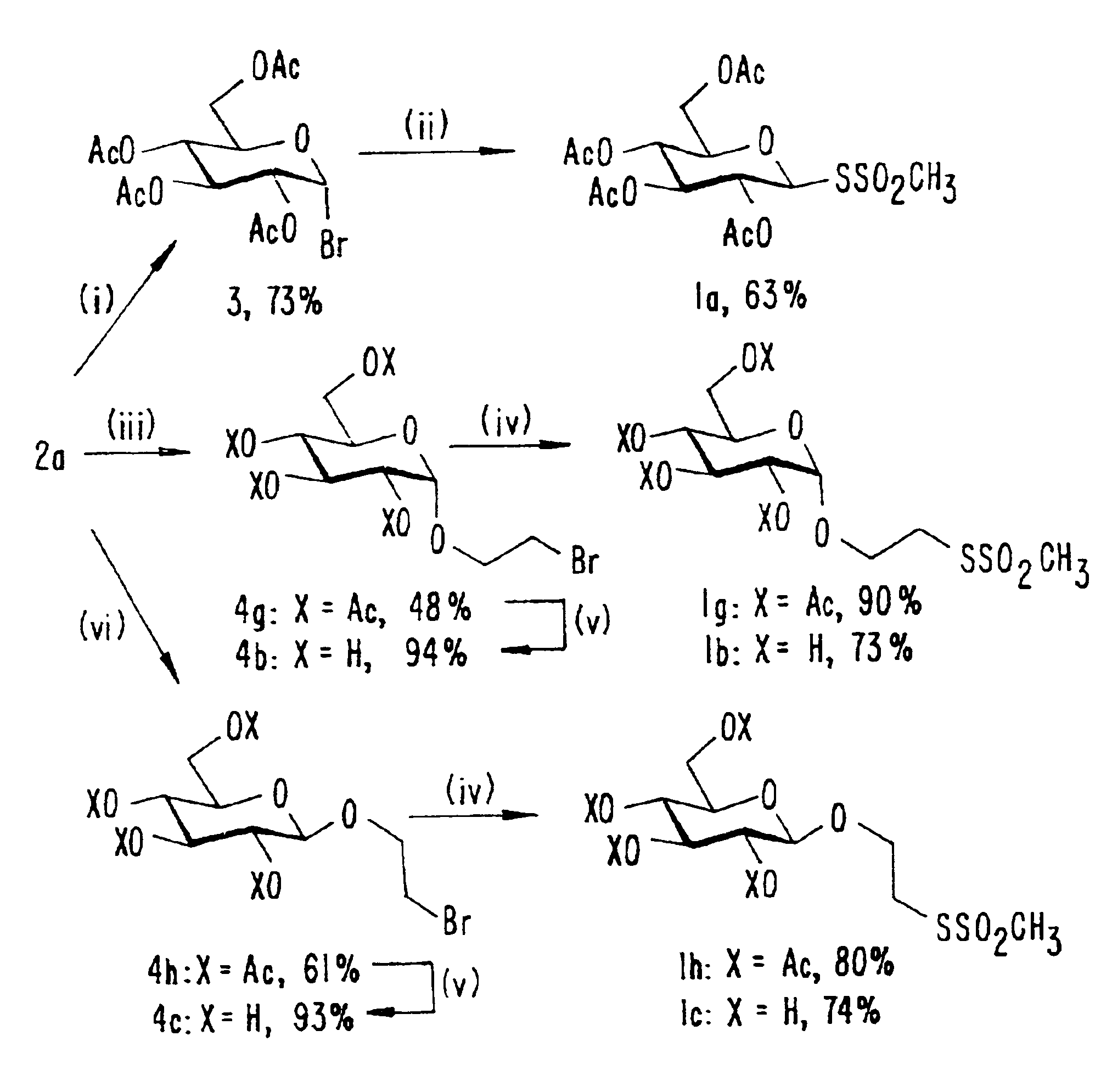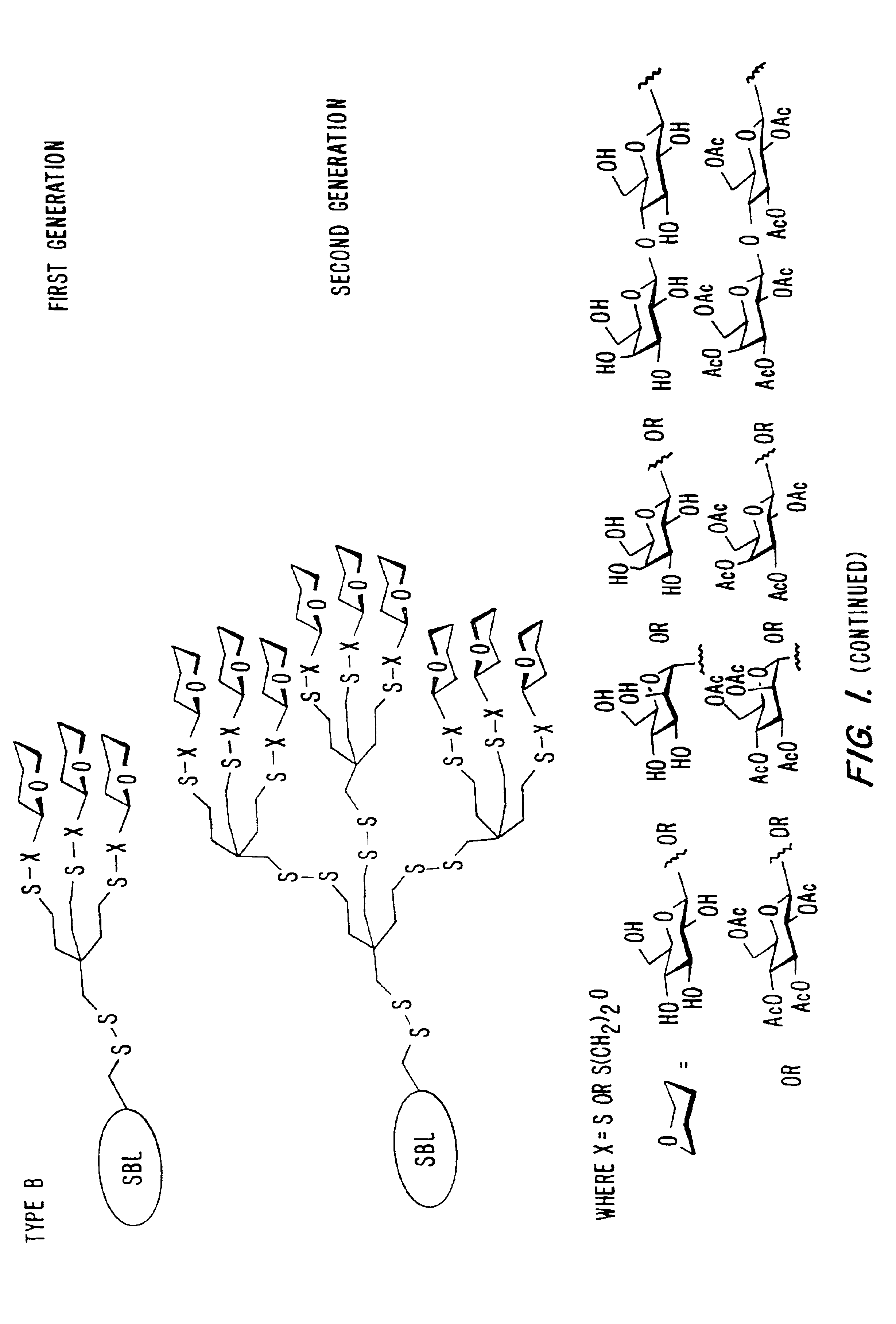Chemically modified proteins with a carbohydrate moiety
a technology of carbohydrate moiety and protein, applied in the field of chemically modified proteins with a carbohydrate moiety, can solve the problems of enzymes that cannot accept all structures of synthetic chemical interest, cannot always be stereospecifically transformed, and cannot be applied in most laboratories. achieve the effects of simple and repeatable manner, increase esterase activity, and altered catalytic activity
- Summary
- Abstract
- Description
- Claims
- Application Information
AI Technical Summary
Benefits of technology
Problems solved by technology
Method used
Image
Examples
example 1
Preparation of Methanethiosulfonate (“MTS”) Reagents
[0075]The preparation of NaSSO2CH3 (Kenyon et al., Methods Enzymol., 47:407-430 (1977), which is hereby incorporated by reference) has been described previously (Berglund et al., J. Am. Chem. Soc., 119:5265-5266 (1997), which is hereby incorporated by reference). Acetobromoglucose (3) (See FIG. 6) (prepared from D-glucose according to Scheurer et al., J. Am. Chem. Soc., 76:3224 (1954), which is hereby incorporated by reference) in 73% yield, pentaacetylglucose (prepared from the corresponding parent carbohydrates according to the method of Verley et al., Ber. Dtsch. Chem. Ges., 34:3354-3358 (1901), which is hereby incorporated by reference, and purified by flash chromatography) in 99% yield, 5d (See FIG. 7) (prepared from the corresponding parent carbohydrates according to the method of Verley et al., Ber. Dtsch. Chem. Ges., 34:3354-3358 (1901), which is hereby incorporated by reference, and purified by flash chromatography) in 92%...
example 2
General Procedure for Modification of Subtilisin Bacillus lentus (“SBL”) Mutants Stored as Flash-Frozen Solutions
[0089]A 1.25 mL frozen aliquot of the mutant enzyme (SBL-N62C, -L217C, or -S166C) containing approximately 25 mg of enzyme was thawed and added to 1.25 mL of Modifying Buffer (see below) in a polypropylene test-tube. To this solution was added 100 uL of a 0.2 M glyco-MTS reagent solution (1a, g-k in MeCN, 1b-f in water (See FIG. 8)). The mixture was sealed, vortexed, and placed on an end-over-end rotator at room temperature. When the modification was complete (determined by a specific activity assay, using succinyl-AlaAlaProPhe-p-nitroanilide [ε410=8800 M−1 cm−1] (Bonneau et al., “Alteration of the Specificity of Subtilisin BPN′ by Site-Directed Mutagenesis in its S1 and S1′ Binding-Sites,”J. Am. Chem. Soc., 119:1026-1030 (1991), which is hereby incorporated by reference) as substrate in 0.1 M Tris-HCl buffer containing 0.005% Tween 80, 1% DMSO, pH 8.6 showing constant ac...
example 3
General Procedure for Modification of SBL Mutants Stored as Lyophilized Powders
[0091]This procedure was only used with S156C, which is stored as a lyophilized powder to prevent dimerization. Into a polypropylene test tube was weighed about 25-30 mg of lyophilized S156C. This was dissolved in the following modifying buffers (2.5 mL):
[0092]
pH 9.5: 70 mM CHES, 2 mM CaCl2pH 7.5: 70 mM HEPES, 2 mM CaCl2pH 6.5: 70 mM MES, 2 mM CaCl2pH 5.5: 70 mM MES, 2 mM CaCl2
Glyco-MTS reagent was added and the reaction then proceeded as for the other mutants, using the appropriate quench buffer. MS m / z (ES-MS): S156C-S-a (See FIG. 8) calculated 27076, found 27079; S156C-S-b (See FIG. 8) calculated 26952, found 26955; S156C-S-c (See FIG. 8) calculated 26952, found 26952; S156C-S-d (See FIG. 8) calculated 26952, found 26952; S156C-S-e (See FIG. 8) calculated 26952, found 26952; S156C-S-f (See FIG. 8) calculated 27114, found 27115; S156C-S-g (See FIG. 8) calculated 27120, found 27123; S156C-S-h (S...
PUM
| Property | Measurement | Unit |
|---|---|---|
| pH | aaaaa | aaaaa |
| pH | aaaaa | aaaaa |
| pH | aaaaa | aaaaa |
Abstract
Description
Claims
Application Information
 Login to View More
Login to View More - R&D
- Intellectual Property
- Life Sciences
- Materials
- Tech Scout
- Unparalleled Data Quality
- Higher Quality Content
- 60% Fewer Hallucinations
Browse by: Latest US Patents, China's latest patents, Technical Efficacy Thesaurus, Application Domain, Technology Topic, Popular Technical Reports.
© 2025 PatSnap. All rights reserved.Legal|Privacy policy|Modern Slavery Act Transparency Statement|Sitemap|About US| Contact US: help@patsnap.com



